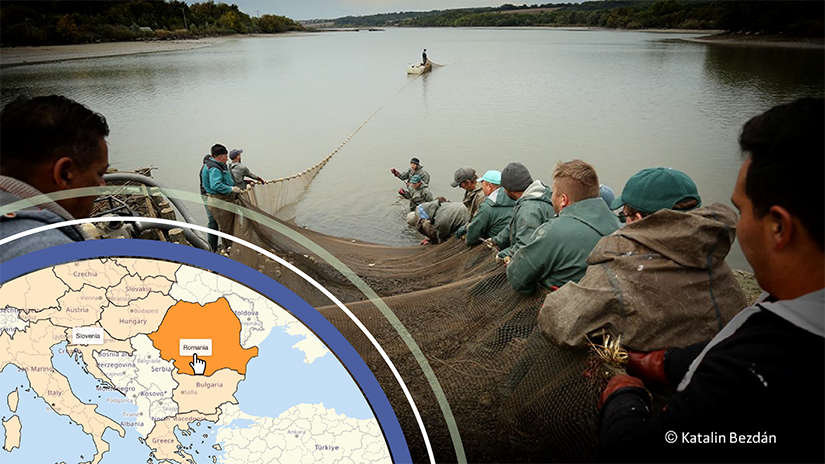Background information

Είδος εκτρεφόμενου είδους
Κυπρίνος (διαφορετικά είδη), πέστροφα (διαφορετικά είδη), πέστροφα (Mississippi paddlefish)(Polyodonspathula), Sturgeon (διαφορετικά είδη).
Πηγή: 2023, EUMOFA· 2022, ΕΤΟΕΑ
Τύπος μεθόδου παραγωγής
Σύμφωνα με την Eurostat, η δραστηριότητα υδατοκαλλιέργειας στη Ρουμανία περιορίζεται στην καλλιέργεια γλυκών υδάτων. Η παραγωγή συνίσταται στο σύνολό της σε λίμνες.
Πηγή: 2023, EUMOFA
Μέγεθος τομέα (παραγωγή και κατανάλωση)
Πηγή: 2023, EUMOFA
Τάσεις (παρελθούσες και μελλοντικές)
Πρόσφατα, οι εκτατικές ιχθυοτροφικές εκμεταλλεύσεις έχουν καταστεί πολυλειτουργικές, παρέχοντας υπηρεσίες όπως ο οικολογικός τουρισμός, η ερασιτεχνική αλιεία και οι εκπαιδευτικές δραστηριότητες που σχετίζονται με τη γνώση και την προστασία της υδρόβιας βιοποικιλότητας. Υπάρχει μια τάση διαφοροποίησης και αύξησης του σημερινού φάσματος δραστηριοτήτων υδατοκαλλιέργειας.
Πηγή: Ευρωψάρι
Αντίκτυπος της υδατοκαλλιέργειας στην οικονομία, την αγορά τροφίμων και την αγορά εργασίας της χώρας
- Η αύξηση της παραγωγής υδατοκαλλιέργειας μπορεί να αποδοθεί στην εκτεταμένη ή ημιεντατική παραγωγή κοινού κυπρίνου στην πολυκαλλιέργεια.
- Η παραγωγή νέων ειδών υδατοκαλλιέργειας στη Ρουμανία, όπως ο οξύρρυγχος, εξακολουθεί να είναι χαμηλή.
- Η Salmonicultura είναι ο τομέας που αναπτύσσεται συνεχώς. Επί του παρόντος, οι εγκαταστάσεις σαλμονικόλης στη Ρουμανία έχουν ως κύριο αντικείμενο τα ακόλουθα είδη: ιριδίζουσα πέστροφα (Oncorhynchus mykiss), πέστροφα η κοινή (Salvelinus fontinalis) και πέστροφα αυτόχθονη (Salmo trutta fario).
- Η θαλάσσια υδατοκαλλιέργεια παρουσιάζει σχετικά πρόσφατη εξέλιξη στον Εύξεινο Πόντο και ιδίως στις ακτές της Ρουμανίας.
- Όσον αφορά την κατανομή ανά περιφέρεια ανάπτυξης, το 2019 σημειώνεται ότι το μεγαλύτερο μερίδιο της παραγωγής που επιτεύχθηκε αντιπροσωπεύει η βορειοανατολική περιφέρεια ανάπτυξης με 29 % της συνολικής εθνικής παραγωγής, ακολουθούμενη από τις περιφέρειες ανάπτυξης της Νότιας, Νοτιοανατολικής, Βορειοδυτικής και Κεντρικής Ευρώπης με μερίδιο μεταξύ 9 και 21 %. Το πολύ μικρό μερίδιο της παραγωγής στις νοτιοδυτικές περιοχές και στις περιοχές Bucharest-Ilfov οφείλεται στις περισσότερες αλιευτικές εγκαταστάσεις κυρίως για ερασιτέχνες γεωργούς.
- Η κατανάλωση προϊόντων αλιείας και υδατοκαλλιέργειας είναι πολύ χαμηλότερη από τον μέσο όρο της ΕΕ. Στη ρουμανική οικιακή κατανάλωση κυριαρχούν τα ζωντανά/νωπά ψάρια, ακολουθούμενα από κατεψυγμένα ψάρια και μαριναρισμένα και παρασκευασμένα προϊόντα. Τα τέσσερα κορυφαία προτιμώμενα είδη είναι η πέστροφα, ο κυπρίνος, το σκουμπρί και ο σολομός.
Πηγή: MNSPA
Προκλήσεις και ευκαιρίες
- Η θήρευση από άγρια πτηνά και ζώα αποτελεί μεγάλο πρόβλημα.
- Νομοθετική αστάθεια, έλλειψη ενιαίας προσέγγισης και αδικαιολόγητοι διοικητικοί φραγμοί.
- Ασαφές νομικό καθεστώς της γης στην οποία βρίσκονται οι εκμεταλλεύσεις υδατοκαλλιέργειας.
- Έλλειψη γενικού κτηματολογίου στη Ρουμανία.
- Άλλοι εξωτερικοί περιορισμοί περιλαμβάνουν την κλιματική αλλαγή, την εκλαμβανόμενη έλλειψη καινοτομίας και την αναποτελεσματική συνεργασία μεταξύ γεωργών και επιστημών.
- Η υπεράκτια θαλάσσια καλλιέργεια της Ρουμανίας εξαρτάται από την ανάπτυξη εξοπλισμού πλοίων για την αντιμετώπιση των υδρομετεωρολογικών συνθηκών που χαρακτηρίζουν τον Εύξεινο Πόντο. Οι κύριοι περιοριστικοί παράγοντες που εντοπίστηκαν είναι η έλλειψη προστατευόμενων περιοχών, καταιγίδων και χαμηλών χειμερινών θερμοκρασιών, οι οποίες ενδέχεται να θέσουν σε κίνδυνο την παραγωγή.
- Έλλειψη εργατικού δυναμικού.
- Περιορισμοί στην εφαρμογή των περιβαλλοντικών κανονισμών: Μπορεί να οδηγήσει σε απώλεια της αλιείας και του εισοδήματος και, τελικά, στην εγκατάλειψή τους.
- Η πρόσβαση περιορίζεται σε συστήματα πιστώσεων που προορίζονται για την παραγωγή προϊόντων υδατοκαλλιέργειας με χρονοβόρες διαδικασίες για την έγκρισή τους.
- Παθολογική κατάσταση, επιζωοτίες.
- Οι χερσαίοι πόροι της χώρας και η διαθεσιμότητα εσωτερικών υδάτων παρέχουν εξαιρετικές συνθήκες για την ιχθυοκαλλιέργεια.
- Προτείνεται η εισαγωγή νέων ειδών στην υδατοκαλλιέργεια σε εντατικά, κλειστά συστήματα εκτροφής που επανακυκλοφορούν, τα οποία μειώνουν την πιθανότητα διαφυγής των εν λόγω ειδών στο φυσικό περιβάλλον. Ωστόσο, η καλλιέργεια κυπρινιδών στην πολυκαλλιέργεια είναι ο τύπος ολοκληρωμένης πολυτροφικής υδατοκαλλιέργειας, η οποία, όσον αφορά τους περιβαλλοντικούς στόχους, έχει το πλεονέκτημα της διατήρησης ή της βελτίωσης της ποιότητας των υδάτων και της συμβολής, μέσω της ανακύκλωσης θρεπτικών ουσιών, στην κυκλική οικονομία ως καθαρό πάροχο περιβαλλοντικών υπηρεσιών στην κοινωνία.
- Υπάρχει επιθυμία για περιφερειακή ανάπτυξη από επιστημονική και τεχνολογική άποψη στον τομέα της θαλάσσιας υδατοκαλλιέργειας.
- Αυξημένη προσβασιμότητα σε τεχνολογίες ανανεώσιμων πηγών ενέργειας.
- Κατά πόσον είναι δυνατόν να προβλεφθούν απαιτήσεις ζωοτροφών για την καλλιέργεια μελιτζάνας από εσωτερικούς πόρους.
- Δυνατότητες για τουρισμό, ερασιτεχνική αλιεία και άλλες δραστηριότητες συμπληρωματικές της υδατοκαλλιέργειας.
- Παραγωγή ζωοτροφών σε κόκκους στη Ρουμανία.
- Διαθεσιμότητα τεχνολογίας για την υλοποίηση της ψηφιοποίησης των διαδικασιών.
- Χρηματοδοτικά μέσα.
(Πηγή: Ευρωψαρίδια-MNSPA)
Απασχόληση και αριθμός επιχειρήσεων
504 επιχειρήσεις και 2231 εργαζόμενοι το 2018.
Πηγή: Ευρωψάρι
Multi-annual National Strategic Plans for the development of sustainable Aquaculture
Relevant Authorities
Applicable Legislation
- Νόμος αριθ. 192 «Σχετικά με τους έμβιους υδρόβιους πόρους, την αλιεία και την υδατοκαλλιέργεια»
- Έκτακτο κυβερνητικό διάταγμα αριθ. 23/2008 για την αλιεία και την υδατοκαλλιέργεια (όπως συμπληρώθηκε και τροποποιήθηκε με τον νόμο αριθ. 317/2009)
- Διάταγμα αριθ. 332/2008 σχετικά με την καταχώριση των μονάδων παραγωγής υδατοκαλλιέργειας στο μητρώο μονάδων υδατοκαλλιέργειας και την έκδοση της άδειας υδατοκαλλιέργειας
Applicable Procedures
- Άδεια υδατοκαλλιέργειας
- ΜΗΤΡΩΟ ΕΓΚΑΤΑΣΤΑΣΕΩΝ ΥΔΑΤΟΚΑΛΛΙΕΡΓΕΙΑΣ
National associations and networks
Relevant Websites
- Εθνικό Ινστιτούτο Έρευνας και Ανάπτυξης Δέλτα του Δούναβη
- Αρχή καταφυγίου βιόσφαιρας στο Δέλτα του Δούναβη
- Ο σταθμός έρευνας και ανάπτυξης στον τομέα της ιχθυοκαλλιέργειας
- Εθνικό Ινστιτούτο Θαλάσσιας Έρευνας και Ανάπτυξης «Grigore Antipa»
- Ινστιτούτο Έρευνας και Ανάπτυξης για την Υδατική Οικολογία, την Αλιεία και την …
Contact Details
Εθνική Υπηρεσία Αλιείας και Υδατοκαλλιέργειας
Alexandru Gheorghe, Σύμβουλος
- Ταχυδρομείο
- Αριθ. τηλεφώνου: 0374 466 140
